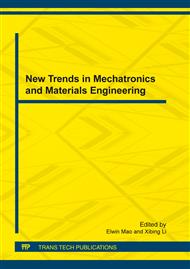[1]
F Schaffalitzky, A Zisserman.Viewpoint invariant texture matching and wide baseline stero[c]// IEEE International Conference on In Computer Vision, 2001. ICCV 2001:636~643.
DOI: 10.1109/iccv.2001.937686
Google Scholar
[2]
T K anade, M Okutomi.A stereo matching algorithm with an adaptive window[J].Theory and experiment,1994, 16 (9):920~931.
Google Scholar
[3]
Yoon K J, Kwen I S. Adaptive support-weight approach for correspondence search[J]. IEEE Trans Pattern Analysis and Machine Intelligence, 2006, 28(4): 650-656.
DOI: 10.1109/tpami.2006.70
Google Scholar
[4]
Tombari F, Mattoccia S, Stefano L D. Segmentation-based adaptive support for accurate stereo correspondence[C]∥Springer Lecture Notes in Computer Science. Berlin/Heidelberg: Springer, 2007: 427-438.
DOI: 10.1007/978-3-540-77129-6_38
Google Scholar
[5]
Boykov Y, Veksler O, Zabih R. Fast approximate energy minimization via graph cuts[J]. IEEE TransPattern Analysis and Machine Intelligence, 2001, 23(11): 1 222-1 239.
DOI: 10.1109/34.969114
Google Scholar
[6]
Kolmogorov V,Zabih R. Multi-camera scene reconstruction via graph cuts[C]∥the 3th European Conference on Computer Vision.2002:82-96.
DOI: 10.1007/3-540-47977-5_6
Google Scholar
[7]
Kolmogorov V,Zabih R. Computing visual correspondence with occlusions using graph cuts[C],//Proceedings of the 8th International Conference on Computer Vision, Vancouver, Canada,2001:508-515.
DOI: 10.1109/iccv.2001.937668
Google Scholar
[8]
ZHANG Lingtao, QU Daokui,XU Fang. An Improved Stereo Matching Algorithm Based on Graph Cuts [J]. Robot, 2010-01-0104-05:1002-0446
DOI: 10.3724/sp.j.1218.2010.00104
Google Scholar
[9]
L.R. Ford,Jr.and D.R. Fulkerson.Flows in Networks[R],Princeton University Press,Princeton. NJ. 1962.
Google Scholar
[10]
Yuri Boykov and Vladimir Kolmogorov.An Experimental Comparison of Min-Cut/ Max-Flow Algorithms for Energy Minimization in Vision[C] //In IEEE Transactions on PAMI, Sept, 2004, 26(9):1124-1137.
DOI: 10.1109/tpami.2004.60
Google Scholar
[11]
Birchfield S, Tomasi C. A pixel dissimilarity measure that is insensitive to image sampling [J]. IEEE Trans Pattern Analysis and Machine Intelligence,1998, 20(4): 401-406.
DOI: 10.1109/34.677269
Google Scholar
[12]
Scharstein D, Szeliski R.A Taxonomy and Evaluation of Dense Two-Frame Stereo Correspondence Algorithms[J]. International Journal of Computer Vision,2002,47:7-42.
DOI: 10.1109/smbv.2001.988771
Google Scholar
[13]
International research community of stereo matching algorithm.the latest performance evaluation report of all algorithm submitted[EB/OL]. [2009-03-21]. http:∥vision.middlebury.edu/stereo/eval, 200.
Google Scholar


